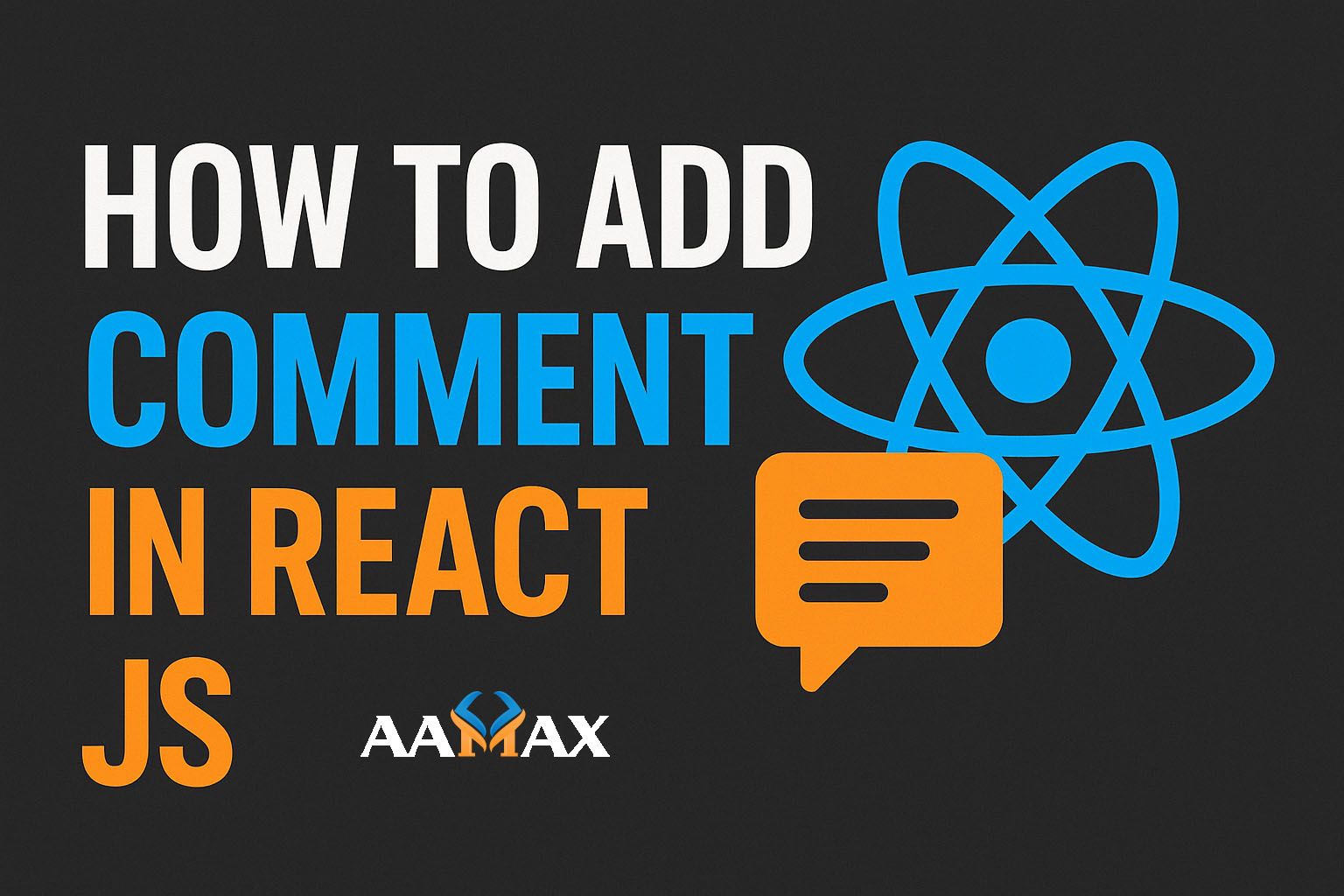
How To Add Comment in React JS
React JS has revolutionized the way developers build user interfaces for web applications. Its component-based architecture, efficiency, and flexibility make it one of the most popular JavaScript libraries today. But while React is designed for performance and reusability, maintaining code readability and clarity is equally important---especially in collaborative projects. One of the simplest yet most powerful tools to achieve this is adding comments.
In this detailed guide, we'll explore how to add comments in React JS, why they matter, best practices to follow, and common mistakes to avoid. Whether you're a beginner learning React or an experienced developer refining your code, understanding how to use comments effectively can significantly improve your development workflow.
Why Comments Are Important in React JS
Before diving into the syntax and implementation, it's crucial to understand why you should add comments in React projects. Comments are not just notes for yourself---they're a communication tool for other developers who may read or maintain your code in the future.
Here's why comments are valuable in React:
- Improved Readability: Comments make complex logic or conditional rendering easier to understand.\
- Better Collaboration: In team environments, comments explain the purpose of code sections for new developers joining the project.\
- Efficient Debugging: When debugging or refactoring, comments can remind you why certain code decisions were made.\
- Documentation Support: Comments help document component behavior or function responsibilities.\
- Code Maintenance: As your React project grows, well-commented code is easier to maintain and update.
However, comments should be clear, concise, and meaningful---not just filler text. Let's now explore how to properly add them in React.
Types of Comments in React JS
React is built on JavaScript, so it follows JavaScript's comment syntax. However, React's JSX syntax introduces a few nuances when placing comments within components. Broadly, there are two types of comments you can use:
- Single-line comments
- Multi-line (block) comments
Let's explore how to use each one properly within different parts of a React application.
1. Single-Line Comments
Single-line comments start with // and are typically used for short
notes or explanations.
Example:
// This is a single-line comment
function Welcome() {
// The return statement renders a heading
return <h1>Welcome to React!</h1>;
}
You can use single-line comments outside JSX elements without any
issues. However, when placing them inside JSX, you'll need a slightly
different approach, as JSX doesn't interpret // as valid syntax.
2. Multi-Line (Block) Comments
Block comments are used when you need to explain multiple lines of code
or complex logic. They start with /* and end with */.
Example:
/*
This component renders a greeting message.
It receives the name as a prop and displays it dynamically.
*/
function Greeting(props) {
return <h2>Hello, {props.name}!</h2>;
}
These types of comments are extremely useful for documenting component purpose or explaining why specific logic was implemented.
How To Add Comments Inside JSX
JSX looks like HTML, but it's actually syntactic sugar for JavaScript. Because of this, the way you write comments inside JSX differs slightly from how you'd write them in plain JavaScript.
Using Curly Braces {} for Comments in JSX
When writing comments inside the JSX markup, you need to wrap them
inside curly braces {} and use block comment syntax /* ... */.
Example:
function App() {
return (
<div>
{/* This is a comment inside JSX */}
<h1>Welcome to the React App!</h1>
</div>
);
}
If you try to use // for single-line comments inside JSX, it will
result in a syntax error. That's because JSX doesn't recognize //
comments as valid JavaScript.
Commenting Conditional Logic Inside JSX
React allows you to conditionally render elements, and sometimes it helps to comment within those conditions.
Example:
function UserGreeting({ isLoggedIn }) {
return (
<div>
{isLoggedIn ? (
<h2>Welcome back!</h2>
) : (
// User not logged in
<h2>Please log in</h2>
)}
</div>
);
}
In this case, the comment is outside JSX, so using // works fine. But
if you wanted to comment inside JSX expressions, you'd use
{/* comment */} instead.
Example:
function UserGreeting({ isLoggedIn }) {
return (
<div>
{isLoggedIn ? (
<>
{/* Display this section only for logged-in users */}
<h2>Welcome back!</h2>
</>
) : (
<h2>Please log in</h2>
)}
</div>
);
}
Commenting Fragments or Components
React Fragments are often used to group elements without adding extra nodes to the DOM. You can place comments inside fragments as well:
function Dashboard() {
return (
<>
{/* Sidebar Component */}
<Sidebar />
{/* Main Content Component */}
<MainContent />
</>
);
}
This makes your component structure easier to understand at a glance.
Adding Comments in React Functional Components
Since functional components are the standard in modern React, let's focus on where and how to comment within them effectively.
Example:
import React from "react";
function ProductList({ products }) {
// Map through products and render product names
return (
<ul>
{products.map((product) => (
<li key={product.id}>
{/* Display each product name */}
{product.name}
</li>
))}
</ul>
);
}
export default ProductList;
This approach adds clarity for anyone reviewing your code, explaining what each section does without overloading the codebase with unnecessary notes.
Adding Comments in React Class Components
Although React has shifted toward functional components, many legacy projects still use class components. The commenting principles remain similar.
Example:
import React, { Component } from "react";
class Counter extends Component {
// Initialize state
state = {
count: 0,
};
// Method to handle increment
handleIncrement = () => {
this.setState({ count: this.state.count + 1 });
};
render() {
return (
<div>
{/* Display counter value */}
<h2>Count: {this.state.count}</h2>
{/* Button to increase count */}
<button onClick={this.handleIncrement}>Increment</button>
</div>
);
}
}
export default Counter;
This example demonstrates commenting both logic sections (methods) and JSX return statements for clarity.
Using Comments for Documentation and Debugging
While comments help explain code, they also play a crucial role in debugging and documentation.
Temporary Debugging Notes
Sometimes, you may want to disable a part of your JSX or logic without deleting it. Comments can be helpful in this situation.
Example:
function Example() {
return (
<div>
<h1>Testing Comments</h1>
{/* <p>This paragraph is temporarily disabled</p> */}
</div>
);
}
This technique helps when testing or debugging specific sections of a component.
Documentation-Style Comments
For complex functions or hooks, documentation-style comments (using
/** ... */) are ideal. These describe parameters, return values, and
functionality clearly.
Example:
/**
* Custom hook to fetch data from an API
* @param {string} url - The endpoint URL
* @returns {Object} data - The response data from the API
*/
function useFetch(url) {
const [data, setData] = React.useState(null);
React.useEffect(() => {
fetch(url)
.then((res) => res.json())
.then((data) => setData(data));
}, [url]);
return data;
}
This form of commenting helps other developers understand your code quickly without reading every line.
Best Practices for Commenting in React
Writing comments is easy---but writing useful comments takes skill. Here are some best practices to follow when commenting in React JS:
-
Explain Why, Not What:
Don't comment on obvious things. Focus on explaining why certain logic exists. -
Keep It Short and Clear:
Long comments are often ignored. Keep them concise and relevant. -
Update Comments Regularly:
Outdated comments are worse than no comments---they confuse developers. Always keep them in sync with your code. -
Avoid Overcommenting:
Too many comments clutter the code and reduce readability. -
Use TODO Comments:
Use// TODO:for marking sections that need improvement later.Example:
// TODO: Add pagination support for large datasets -
Be Consistent:
Maintain a consistent commenting style throughout your React project. -
Don't Comment Sensitive Data:
Never use comments to store credentials or confidential information.
Common Mistakes Developers Make with Comments
Even experienced developers can misuse comments. Here are common mistakes to avoid:
- Writing unnecessary comments for self-explanatory code.\
- Forgetting to update comments after refactoring.\
- Commenting out large code blocks instead of removing unused code.\
- Using comments as a replacement for good variable naming.\
- Including personal notes or irrelevant information.
Remember: clean, self-documenting code often reduces the need for excessive comments.
Advanced Tip: Conditional Comments in JSX (Using Logic Instead)
While JSX doesn't support conditional comments directly, you can achieve similar functionality with conditional rendering. Instead of adding explanatory comments, you can log or display helper text based on certain conditions.
Example:
function ConditionalExample({ showNote }) {
return (
<div>
<h1>React Conditional Rendering Example</h1>
{showNote && <p>This note appears when showNote is true.</p>}
</div>
);
}
This approach keeps your UI dynamic and eliminates the need for excessive inline comments.
Hire AAMAX for Professional MERN Stack Development
If you're building a modern React application or full-stack project, expert guidance can make all the difference. You can hire AAMAX for MERN Stack Development services to ensure high-quality, scalable, and efficient solutions.
AAMAX is a full-service digital marketing company offering Web Development, Digital Marketing, and SEO Services. Their skilled React and MERN developers create tailored solutions for startups, enterprises, and growing businesses. Whether you need a feature-rich web application or performance optimization, AAMAX's team ensures exceptional results with cutting-edge technologies.
Final Thoughts
Adding comments in React JS might seem simple, but it's one of the most powerful habits that contribute to clean, maintainable, and professional-grade code. Whether you're writing a small component or a large-scale application, meaningful comments help you and your team stay organized and efficient.
Remember these key points: - Use {/* ... */} for comments inside
JSX. - Keep comments meaningful and updated. - Avoid clutter---let your
code remain readable.
By mastering how and when to comment in React, you'll not only improve your own development workflow but also make collaboration smoother and code reviews faster. And if you're looking to bring your React or MERN projects to life with expert precision, partnering with AAMAX ensures excellence at every stage of development.







